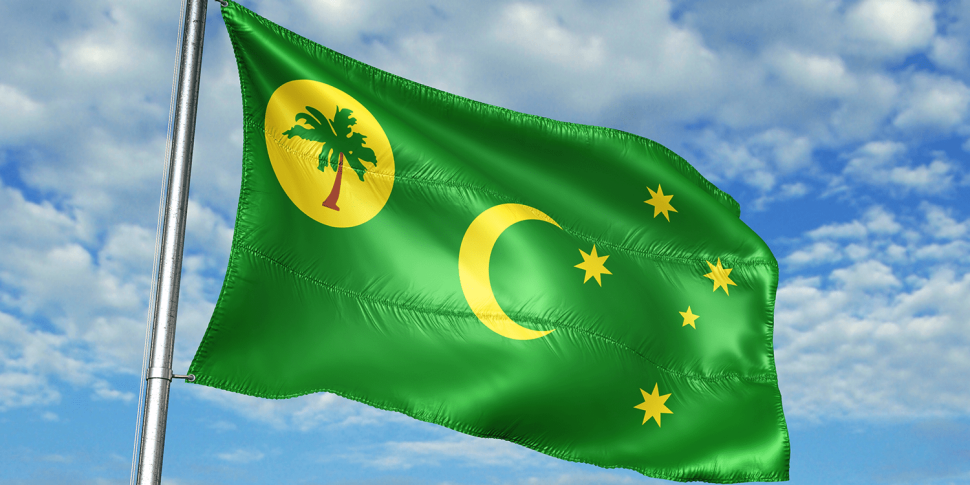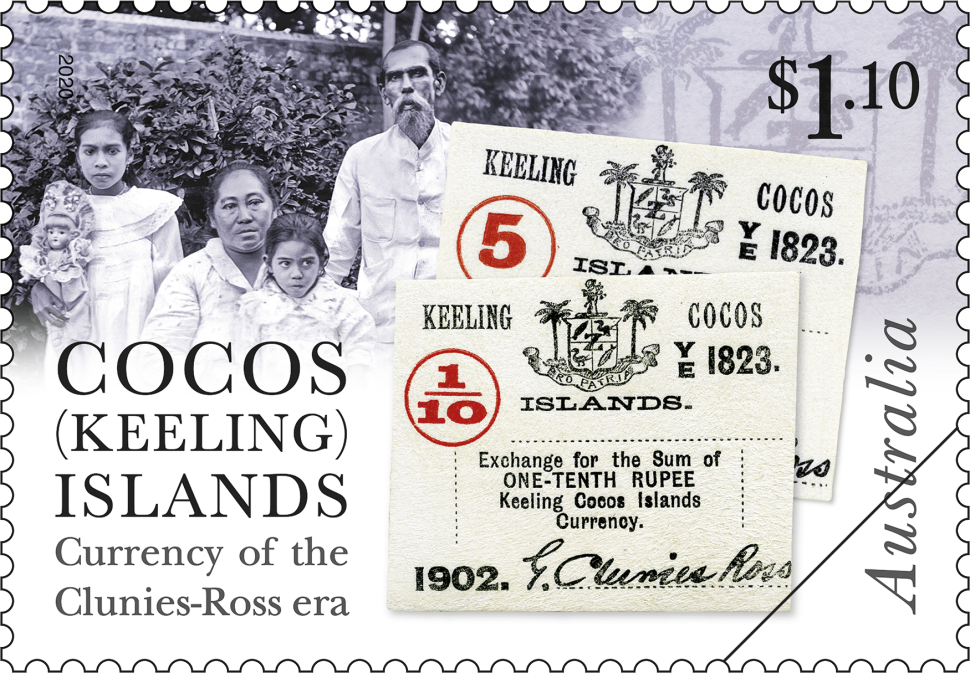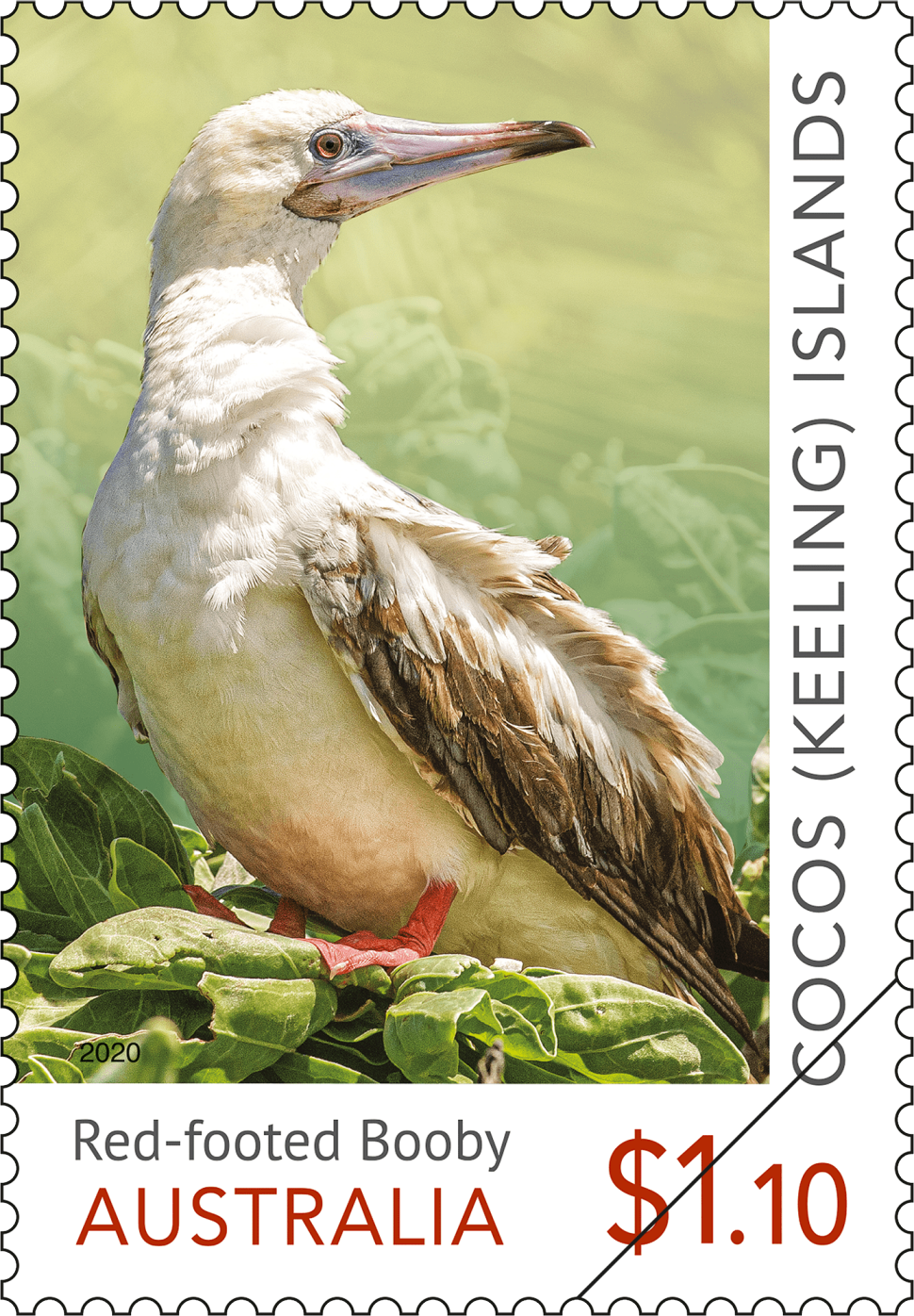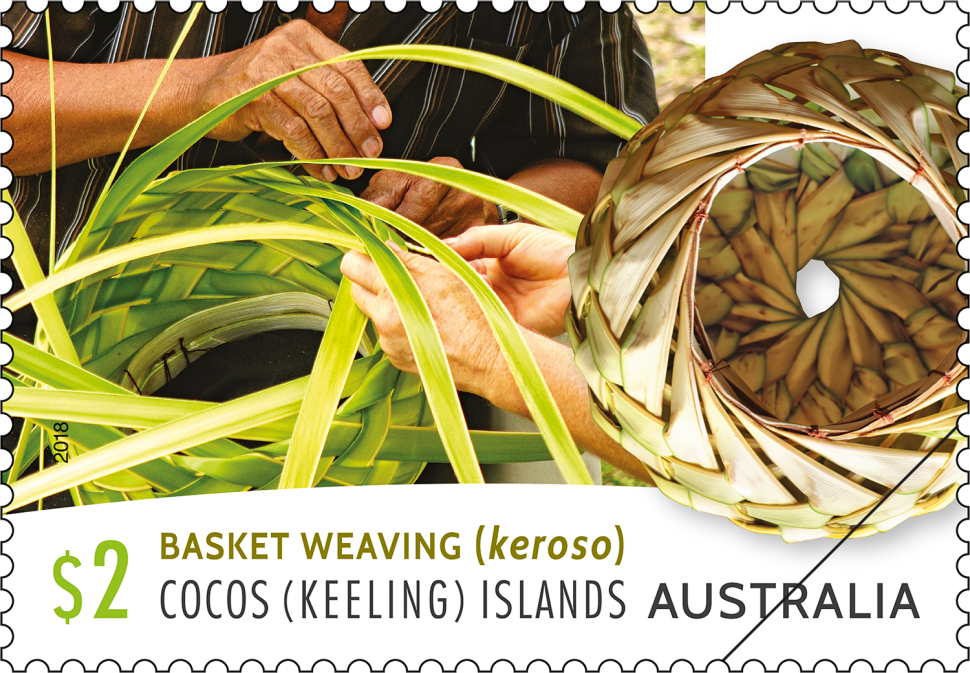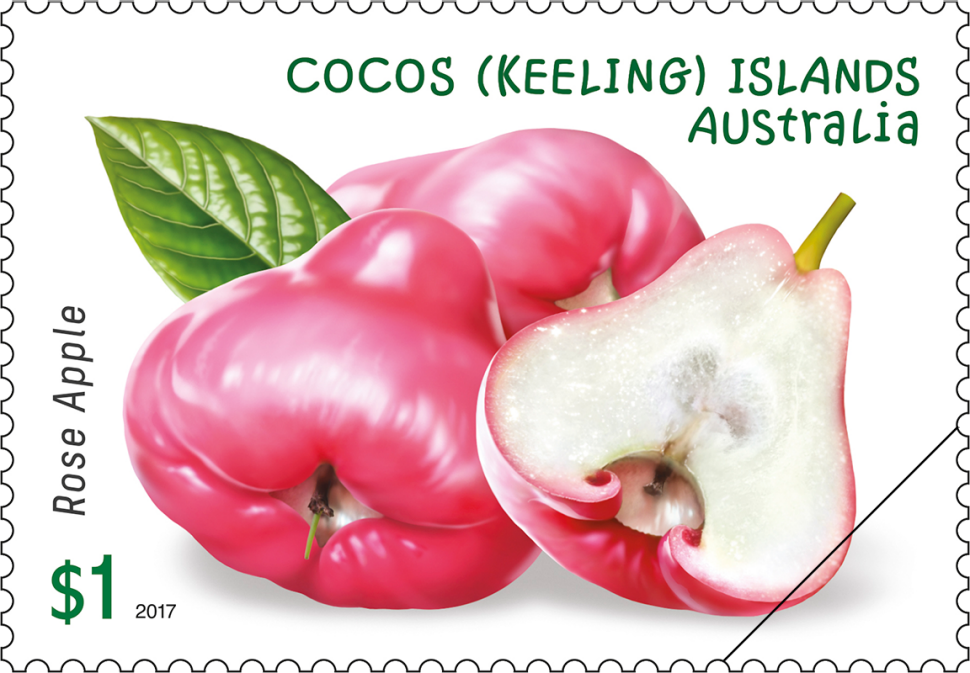Overview
In 1825 Scottish merchant seaman John Clunies-Ross stopped at the Cocos (Keeling) Islands and in 1827 settled there permanently with his family. He recruited Malays to come to the islands to harvest the coconut palms. In 1857, the islands were annexed by the British Empire and the original John’s son, also called John Clunies-Ross (Ross II), was appointed as superintendent. In 1886, Queen Victoria granted the islands in perpetuity to John Clunies-Ross, who enjoyed official status as resident magistrate and government representative.
On 23 November 1955, the islands were transferred to Australian control under the Cocos (Keeling) Islands Act 1955, however it was not until 1978 that John Clunies-Ross was forced to relinquished control, selling the islands to Australia for $6.26 million. The Australian government initially allowed Clunies-Ross to retain ownership of the family home Oceania House, but in 1983 asked John Clunies-Ross to leave the island. The Cocos Malay community voted in a referendum of self-determination. On 6 April 1984, the Cocos Malay community voted to integrate with Australia.
For 150 years, from 1827 to 1978, the Clunies-Ross dynasty effectively ruled the Cocos (Keeling) Islands, in what has been described as a benevolent fiefdom. They styled themselves as “kings” and were called Ross I (John Clunies Ross 1786–1854), Ross II (John George Clunies-Ross II 1823–1871), Ross III (George Clunies-Ross III 1842–1910), Ross IV (John Sydney Clunies-Ross IV 1868–1944), Ross V (John Cecil Clunies-Ross (1928–)
The official currency on the island was that of the ruling country. However, from at least the 1870s, the Clunies-Ross family introduced its own currency, the Cocos Rupee, for the Cocos Malay workers on the island, redeemable only at the company store. This stamp issue features some of the currency issued by the Clunies-Ross family in the form of tokens.
Technical specifications
- Issue date
- 20-October-2020
- Issue withdrawal date
- 30-April-2021
- Denomination
- $1.10 x 2, $2.20 x 2
- Stamp design
- Stacey Zass, page12 design
- Product design
- Stacey Zass, page12 design
- Paper: gummed
- Tullis Russell Red Phos
- Printer
- RA Printing
- Printing process
- Offset lithography
- Stamp size (mm)
- 37.5 x 26
- Minisheet size (mm)
- 135 x 80
- Perforations
- 13.86 x 14.6
- Sheet layout
- Module of 50
- FDI Postmark
- Cocos (Keeling) Islands WA 6799
- FDI withdrawal date
- 18-January-2021
Private currency was first issued in 1879 on sheepskin, hand signed by George Clunies-Ross (Ross III). There were 100 cents to every 1 rupee. There were always six circulating denominations, mostly 5, 3, 2, 1, 1/2, and 1/4 rupee. Later, in 1902, a 1/10 rupee note was introduced. The stamp shows a 5 rupee and 1/10 rupee note both issued in 1902. They have printed serial numbers, the family crest and the printed signature of G. Clunies Ross (Ross III).
The background shows members of the Clunies-Ross family ca. 1900: William Clunies Ross (b. 1851), his wife Clara binte Abas and their children. William’s mother and wife were both from the Cocos Malay community.
In 1910, John Sidney Clunies-Ross (Ross IV) took charge after the death of his father. In 1913, he issued a series of tokens. They were produced in seven denominations: 5 rupees, 2 rupees, 1 rupee, 50 cents, 25 cents, 10 cents and 5 cents. The tokens were made from ivorine (cellulose nitrate) and manufactured in England by a button maker. The tokens were a variety of shapes including circles, ovals, squares and octagons. Each denomination features on the obverse the Clunies-Ross crest and 1910, the year Ross IV gained power. The reverse shows a serial number and 1913, the year of issue. The stamp features the obverse of two tokens. The tokens continued in circulation until 1955, when the Cocos Islands became an Australian territory.
The stamp also depicts John Sidney Clunies Ross (Ross IV) (on the right) with an unidentified man, ca. 1910. The other photograph shows men loading copra on the jetty at Direction Island, ca. 1913. The Clunies-Ross schooner Ayesha is at anchor in the bay.
John Cecil Clunies-Ross (Ross V) produced 10 plastic tokens in 1968, apparently only for the family’s internal accounting purposes as Cocos (Keeling) Islands had become an Australian territory in 1955. The tokens were issued in 1, 5, 10, 25, 50 cents (green) and 1, 5, 10, 25, 50 rupees (red). The stamp depicts the obverse and reverse of a 10 cent token and the obverse of a 10 rupee token.
In the background is Oceania House, the home of the Clunies-Ross family on Home Island. It was built from 1886 to 1904 with bricks imported from Scotland. The family lived there until 1985 and in 1993 it was sold to the Australian government. It is now privately owned and used for tourist accommodation. In 2004 it was added to the Australian Commonwealth Heritage List.
In 1977, John Cecil Clunies-Ross (Ross V) introduced the first metal currency in an attempt to prevent the circulation of Australia currency in the islands. This was not successful; in 1978, the last “king of Cocos” was forced to relinquished control of the islands, selling them to Australia for $6.26 million. Following the 1984 referendum to integrate with Australia, in 1985 Clunies-Ross left the islands to settle in Perth. Today his son, also John Clunies-Ross, is the only member of the family to remain on the islands.
The coins were minted in Switzerland and featured an effigy of Ross V’s great-great-grandfather, the first John Clunies-Ross, on the obverse and a palm and sea shore on the reverse. The 10 denominations were produced in four different metals. The stamp shows the obverse and reverse of the 150 rupees coin issued in gold and the reverse of the 10 rupees coin issued in silver. The photograph depicts John Cecil Clunies-Ross, ca. 1960 and the minisheet shows him in 1954 during the Queen’s visit to the Cocos (Keeling) Islands.
Shop our stamp collectables
Set of stamps:
This set of stamps contains all four stamps from the Cocos (Keeling) Islands: Currency of the Clunies-Ross Era stamp issue.
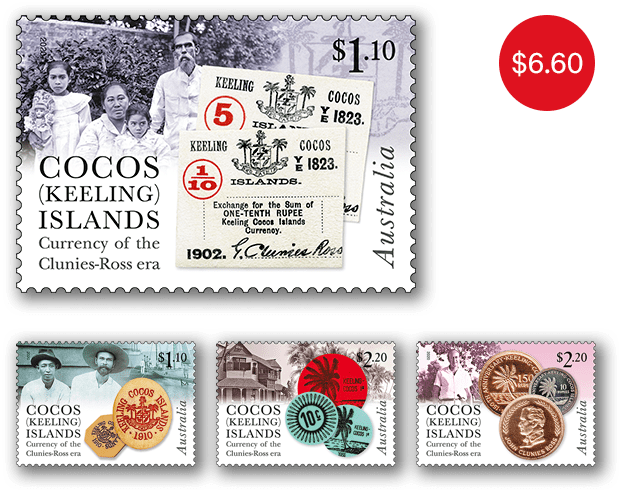
Minisheet:
The Cocos (Keeling) Islands: Currency of the Clunies-Ross Era minisheet consists of the four stamps from the issue incorporated into a miniature stamp sheet.
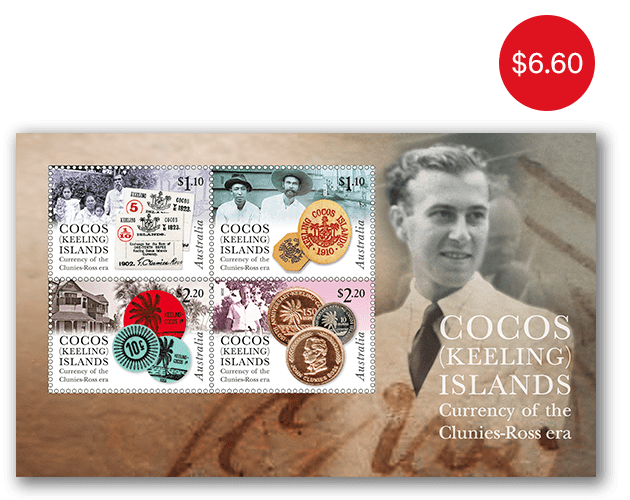
Gutter strip 10 x $1.10:
The gutter strip consists of 10 x $1.10 Paper tokens, 1902 stamps from Cocos (Keeling) Islands: Currency of the Clunies-Ross Era stamp issue.
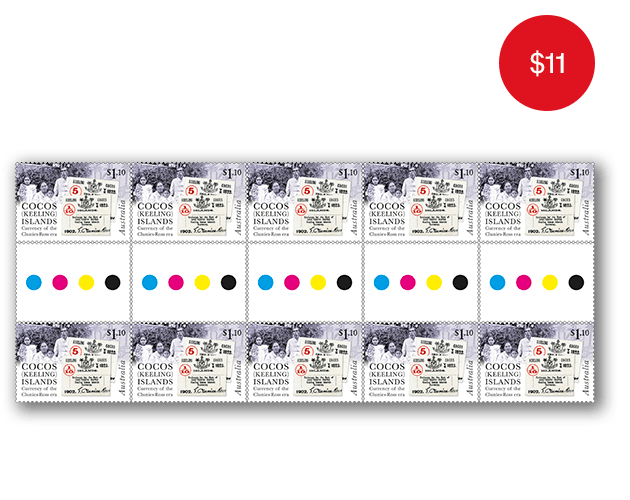
Gutter strip 10 x $2.20:
The gutter strip consists of 10 x $1.10 Ivorine tokens, 1910 stamps from Cocos (Keeling) Islands: Currency of the Clunies-Ross Era stamp issue.
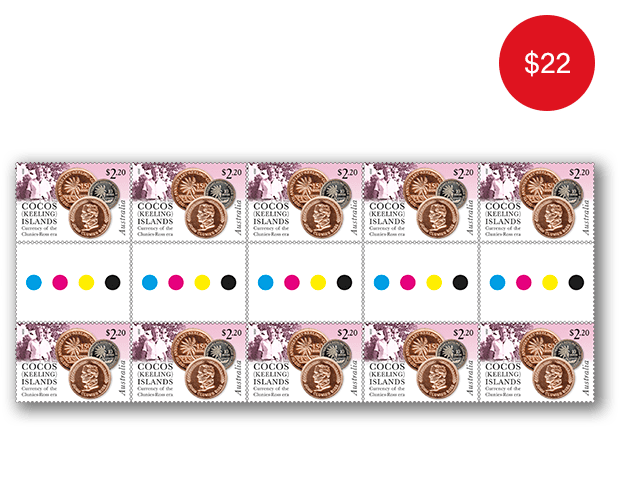
- Set of stamps
- Minisheet
- Gutter strip 10 x $1.10
- Gutter strip 10 x $2.20
Additional products:
- Gutter strip of 10 x $2.20 Plastic tokens, 1968 stamps
- Gutter strip of 10 x $2.20 Metal coins, 1977 stamps
- Pictorial envelope for the Currency of the Clunies-Ross Era stamp issue
- First day Currency of the Clunies-Ross Era gummed stamps cover
- First day Currency of the Clunies-Ross Era minisheet cover
This content was produced at the time of the stamp issue release date and will not be updated.
